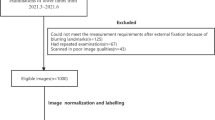Abstract
Deformities of the lower limbs are a common clinical problem encountered in orthopedic practices. Several methods have been proposed for measuring lower limb alignment and joint orientation clinically or using computer-assisted methods. In this work we introduce a new approach for measuring lower limb alignment and joint orientation on the basis of bones segmented by deep neural networks. The bones are segmented on X-ray images using an U-net convolutional neural network. It has been trained on forty manually segmented images. Afterwards, the segmented bones are post-processed using fully connected CRFs. Finally, lines are fitted to pruned skeletons representing the bones. We discuss algorithms for measuring lower limb alignment and joint orientation. We present both qualitative and quantitative segmentation results on ten test images. We compare the results that were obtained manually using a computer-assisted program and by the proposed algorithm.
Access this chapter
Tax calculation will be finalised at checkout
Purchases are for personal use only
Similar content being viewed by others
References
Paley, D.: Normal lower limb alignment and joint orientation In: Principles of Deformity Correction, pp. 1–18. Springer, Heidelberg (2002). https://doi.org/10.1007/978-3-642-59373-4_1
Olczak, J., et al.: Artificial intelligence for analyzing orthopedic trauma radiographs. Acta Orthop. 88, 581–586 (2017)
Cherian, J.J., Kapadia, B.H., Banerjee, S., Jauregui, J.J., Issa, K., Mont, M.A.: Mechanical, anatomical, and kinematic axis in TKA: concepts and practical applications. Curr. Rev. Musculoskelet. Med. 7, 89–95 (2014)
Lohman, M., Tallroth, K., Kettunen, J.A., Remes, V.: Changing from analog to digital images: does it affect the accuracy of alignment measurements of the lower extremity? Acta Orthop. 82, 351–355 (2011)
Yang, N.H., Nayeb-Hashemi, H., Canavan, P.K., Vaziri, A.: Effect of frontal plane tibiofemoral angle on the stress and strain at the knee cartilage during the stance phase of gait. J. Orthop. Res. 28, 1539–47 (2010)
Ariumi, A.: Three-dimensional lower extremity alignment in the weight-bearing standing position in healthy elderly subjects. J. Orthop. Sci. 15, 64–70 (2010)
Sharma, L., Song, J., Felson, D.T., Cahue, S., Shamiyeh, E., Dunlop, D.D.: The role of knee alignment in disease progression and functional decline in knee osteoarthritis. JAMA 286, 188–195 (2001)
Pape, D., Rupp, S.: Preoperative planning for high tibial osteotomies. Operative Techn. Orthop. 17, 2–11 (2007)
Moreland, J., Bassett, L., Hanker, G.: Radiographic analysis of the axial alignment of the lower extremity. J. Bone Joint Surg. Am. 69, 745–749 (1987)
Wu, J., Mahfouz, M.R.: Robust x-ray image segmentation by spectral clustering and active shape model. J. Med Imaging 3, 034005 (2016)
Aganj, I., Harisinghani, M., Weissleder, R., Fischl, B.: Unsupervised medical image segmentation based on the local center of mass. Sci. Rep. 8, 13012 (2018)
Ronneberger, O., Fischer, P., Brox, T.: U-Net: convolutional networks for biomedical image segmentation. In: Navab, N., Hornegger, J., Wells, W.M., Frangi, A.F. (eds.) MICCAI 2015. LNCS, vol. 9351, pp. 234–241. Springer, Cham (2015). https://doi.org/10.1007/978-3-319-24574-4_28
Ioffe, S., Szegedy, C.: Batch normalization: accelerating deep network training by reducing internal covariate shift. In: ICML, vol. 37, pp. 448–456 (2015)
Liu, C., Szeliski, R., Bing Kang, S., Zitnick, C.L., Freeman, W.T.: Automatic estimation and removal of noise from a single image. IEEE Trans. Pattern Anal. Mach. Intell. 30, 299–314 (2008)
Chen, L., Papandreou, G., Kokkinos, I., Murphy, K., Yuille, A.L.: Semantic image segmentation with deep convolutional nets and fully connected CRFs. In: 3rd International Conference on Learning Representations, ICLR 2015 (2015)
Krähenbühl, P., Koltun, V.: Efficient inference in fully connected CRFs with Gaussian edge potentials. In: Proceedings of the 24th International Conference on Neural Information Processing Systems, USA, Curran Associates Inc., pp. 109–117 (2011)
Soille, P.: Morphological Image Analysis: Principles and Applications, 2nd edn. Springer, Heidelberg (2003). https://doi.org/10.1007/978-3-662-05088-0
Felzenszwalb, P.F., Zabih, R.: Dynamic programming and graph algorithms in computer vision. IEEE Trans. Pattern Anal. Mach. Intell. 33, 721–740 (2011)
Author information
Authors and Affiliations
Corresponding author
Editor information
Editors and Affiliations
Rights and permissions
Copyright information
© 2019 Springer Nature Switzerland AG
About this paper
Cite this paper
Kwolek, K., Brychcy, A., Kwolek, B., Marczyński, W. (2019). Measuring Lower Limb Alignment and Joint Orientation Using Deep Learning Based Segmentation of Bones. In: Pérez García, H., Sánchez González, L., Castejón Limas, M., Quintián Pardo, H., Corchado Rodríguez, E. (eds) Hybrid Artificial Intelligent Systems. HAIS 2019. Lecture Notes in Computer Science(), vol 11734. Springer, Cham. https://doi.org/10.1007/978-3-030-29859-3_44
Download citation
DOI: https://doi.org/10.1007/978-3-030-29859-3_44
Published:
Publisher Name: Springer, Cham
Print ISBN: 978-3-030-29858-6
Online ISBN: 978-3-030-29859-3
eBook Packages: Computer ScienceComputer Science (R0)




